System Analysis and Design Project: Quickcabs Online Booking
VerifiedAdded on 2021/02/20
|15
|1903
|36
Project
AI Summary
This assignment provides a comprehensive system analysis and design for Quickcabs, an online car rental platform. It begins with functional specifications for both admin and user roles, outlining their responsibilities and module specifications such as viewing available cars, booking cars, providing feedback, and making inquiries. The project then employs various UML diagrams to illustrate the system's functionality. Use case diagrams depict the interactions between users and the system, activity diagrams model the flow of actions, sequence diagrams detail object interactions over time, and a domain model class diagram represents the system's data structure. State machine diagrams showcase the system's behavior, and user interface designs are also included. The assignment concludes with a summary of the unified modeling language approach, emphasizing its role in software modeling, documentation, and visualization, particularly for the Quickcabs system.
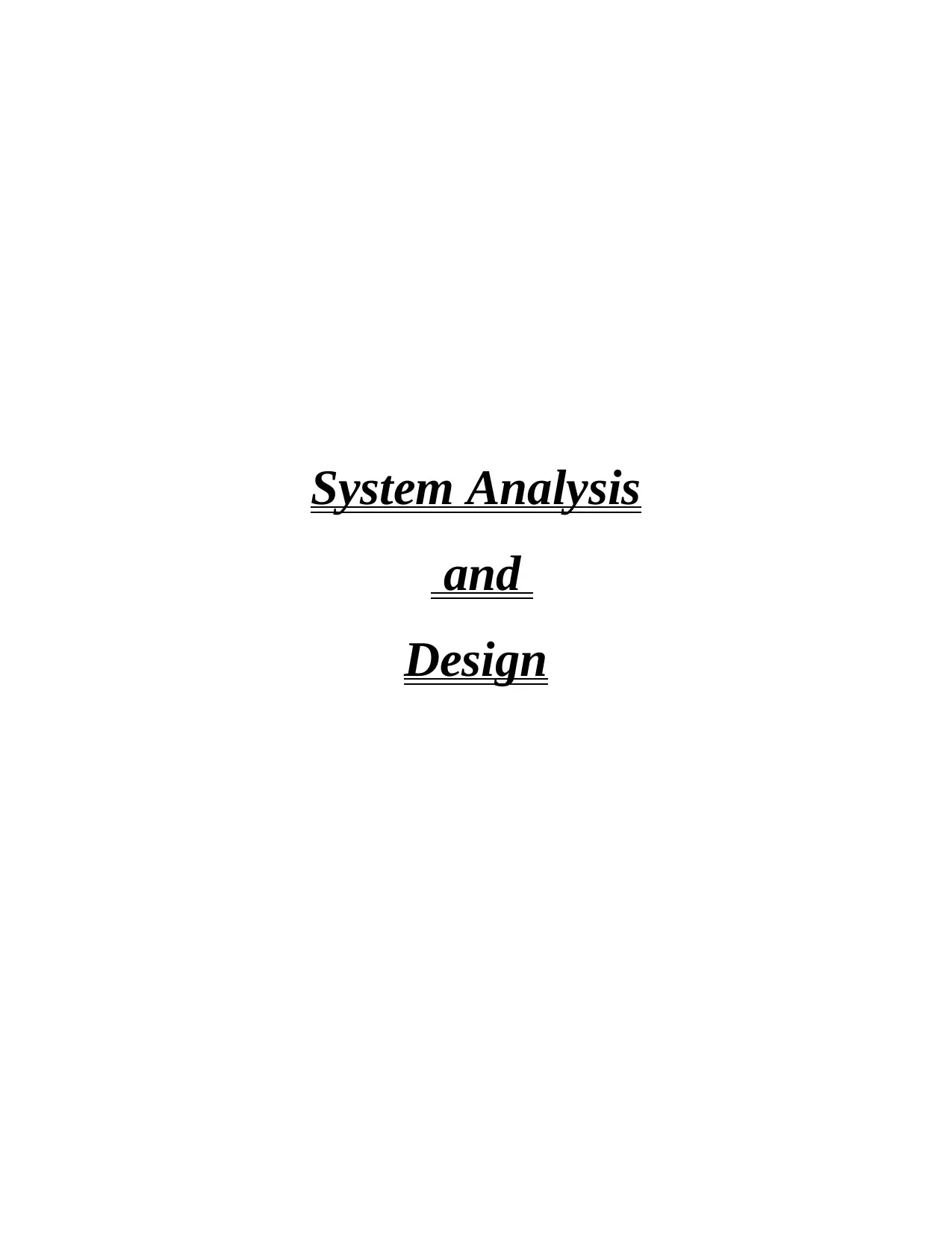
System Analysis
and
Design
and
Design
Paraphrase This Document
Need a fresh take? Get an instant paraphrase of this document with our AI Paraphraser
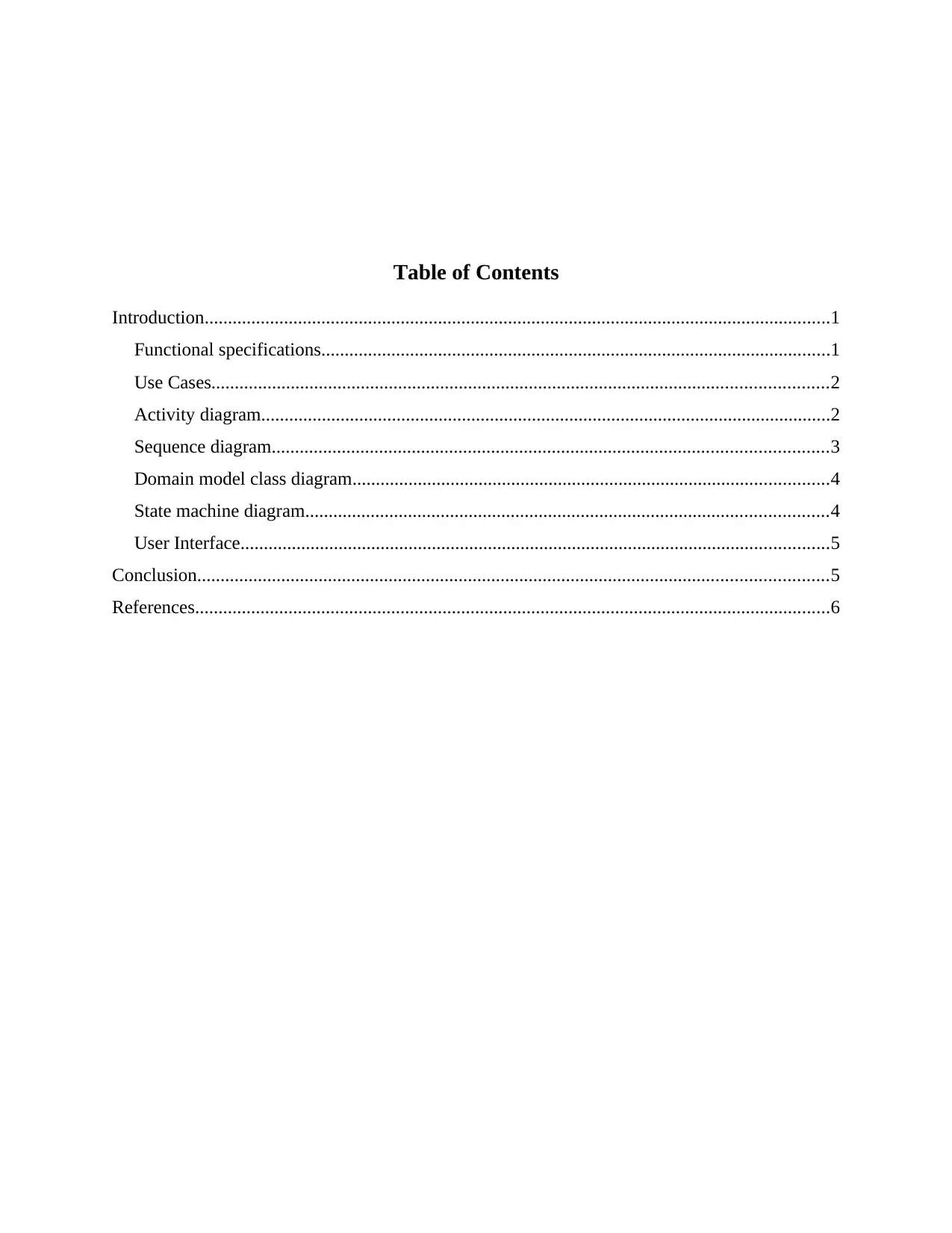
Table of Contents
Introduction......................................................................................................................................1
Functional specifications.............................................................................................................1
Use Cases....................................................................................................................................2
Activity diagram..........................................................................................................................2
Sequence diagram.......................................................................................................................3
Domain model class diagram......................................................................................................4
State machine diagram................................................................................................................4
User Interface..............................................................................................................................5
Conclusion.......................................................................................................................................5
References........................................................................................................................................6
Introduction......................................................................................................................................1
Functional specifications.............................................................................................................1
Use Cases....................................................................................................................................2
Activity diagram..........................................................................................................................2
Sequence diagram.......................................................................................................................3
Domain model class diagram......................................................................................................4
State machine diagram................................................................................................................4
User Interface..............................................................................................................................5
Conclusion.......................................................................................................................................5
References........................................................................................................................................6

⊘ This is a preview!⊘
Do you want full access?
Subscribe today to unlock all pages.

Trusted by 1+ million students worldwide
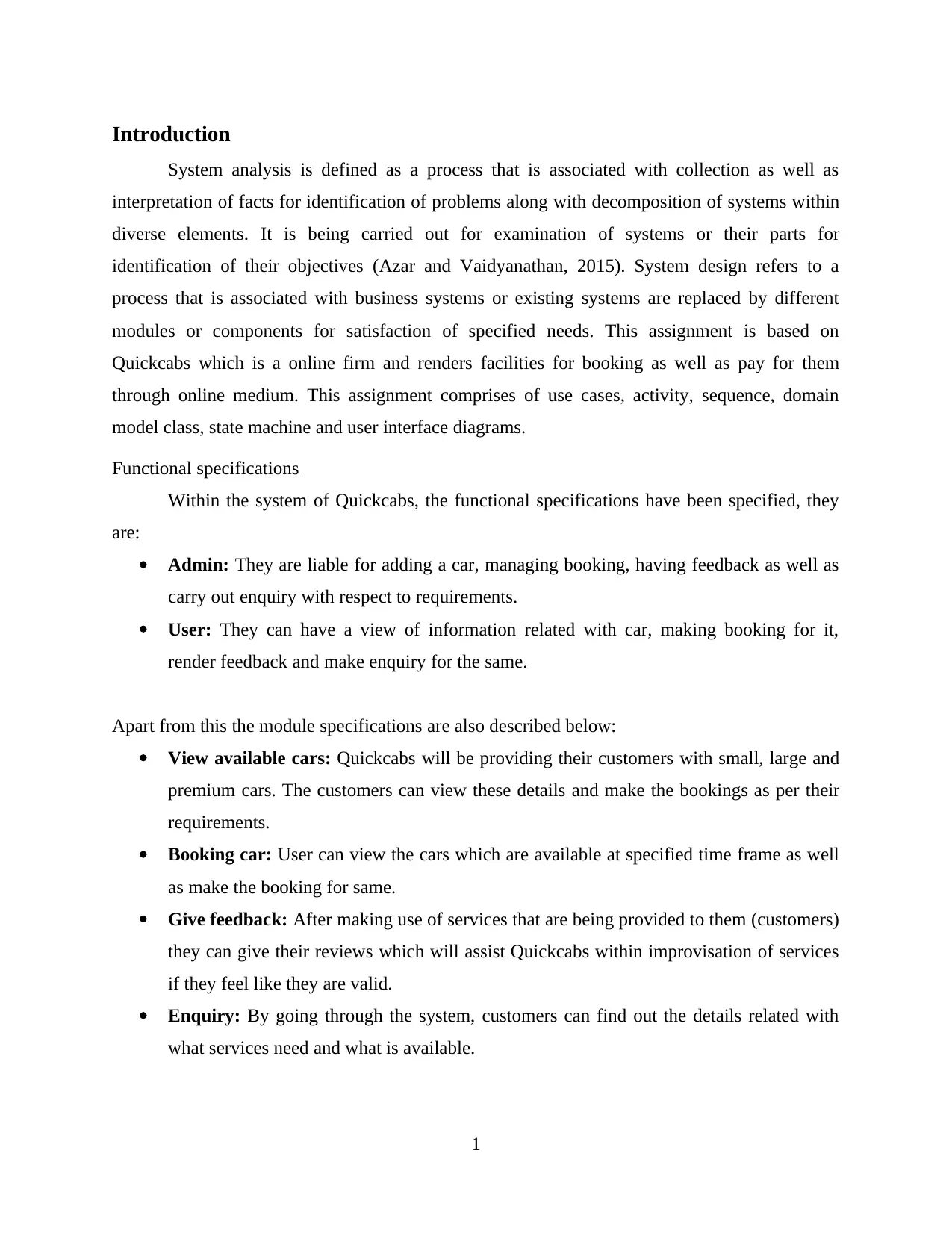
Introduction
System analysis is defined as a process that is associated with collection as well as
interpretation of facts for identification of problems along with decomposition of systems within
diverse elements. It is being carried out for examination of systems or their parts for
identification of their objectives (Azar and Vaidyanathan, 2015). System design refers to a
process that is associated with business systems or existing systems are replaced by different
modules or components for satisfaction of specified needs. This assignment is based on
Quickcabs which is a online firm and renders facilities for booking as well as pay for them
through online medium. This assignment comprises of use cases, activity, sequence, domain
model class, state machine and user interface diagrams.
Functional specifications
Within the system of Quickcabs, the functional specifications have been specified, they
are:
Admin: They are liable for adding a car, managing booking, having feedback as well as
carry out enquiry with respect to requirements.
User: They can have a view of information related with car, making booking for it,
render feedback and make enquiry for the same.
Apart from this the module specifications are also described below:
View available cars: Quickcabs will be providing their customers with small, large and
premium cars. The customers can view these details and make the bookings as per their
requirements.
Booking car: User can view the cars which are available at specified time frame as well
as make the booking for same.
Give feedback: After making use of services that are being provided to them (customers)
they can give their reviews which will assist Quickcabs within improvisation of services
if they feel like they are valid.
Enquiry: By going through the system, customers can find out the details related with
what services need and what is available.
1
System analysis is defined as a process that is associated with collection as well as
interpretation of facts for identification of problems along with decomposition of systems within
diverse elements. It is being carried out for examination of systems or their parts for
identification of their objectives (Azar and Vaidyanathan, 2015). System design refers to a
process that is associated with business systems or existing systems are replaced by different
modules or components for satisfaction of specified needs. This assignment is based on
Quickcabs which is a online firm and renders facilities for booking as well as pay for them
through online medium. This assignment comprises of use cases, activity, sequence, domain
model class, state machine and user interface diagrams.
Functional specifications
Within the system of Quickcabs, the functional specifications have been specified, they
are:
Admin: They are liable for adding a car, managing booking, having feedback as well as
carry out enquiry with respect to requirements.
User: They can have a view of information related with car, making booking for it,
render feedback and make enquiry for the same.
Apart from this the module specifications are also described below:
View available cars: Quickcabs will be providing their customers with small, large and
premium cars. The customers can view these details and make the bookings as per their
requirements.
Booking car: User can view the cars which are available at specified time frame as well
as make the booking for same.
Give feedback: After making use of services that are being provided to them (customers)
they can give their reviews which will assist Quickcabs within improvisation of services
if they feel like they are valid.
Enquiry: By going through the system, customers can find out the details related with
what services need and what is available.
1
Paraphrase This Document
Need a fresh take? Get an instant paraphrase of this document with our AI Paraphraser
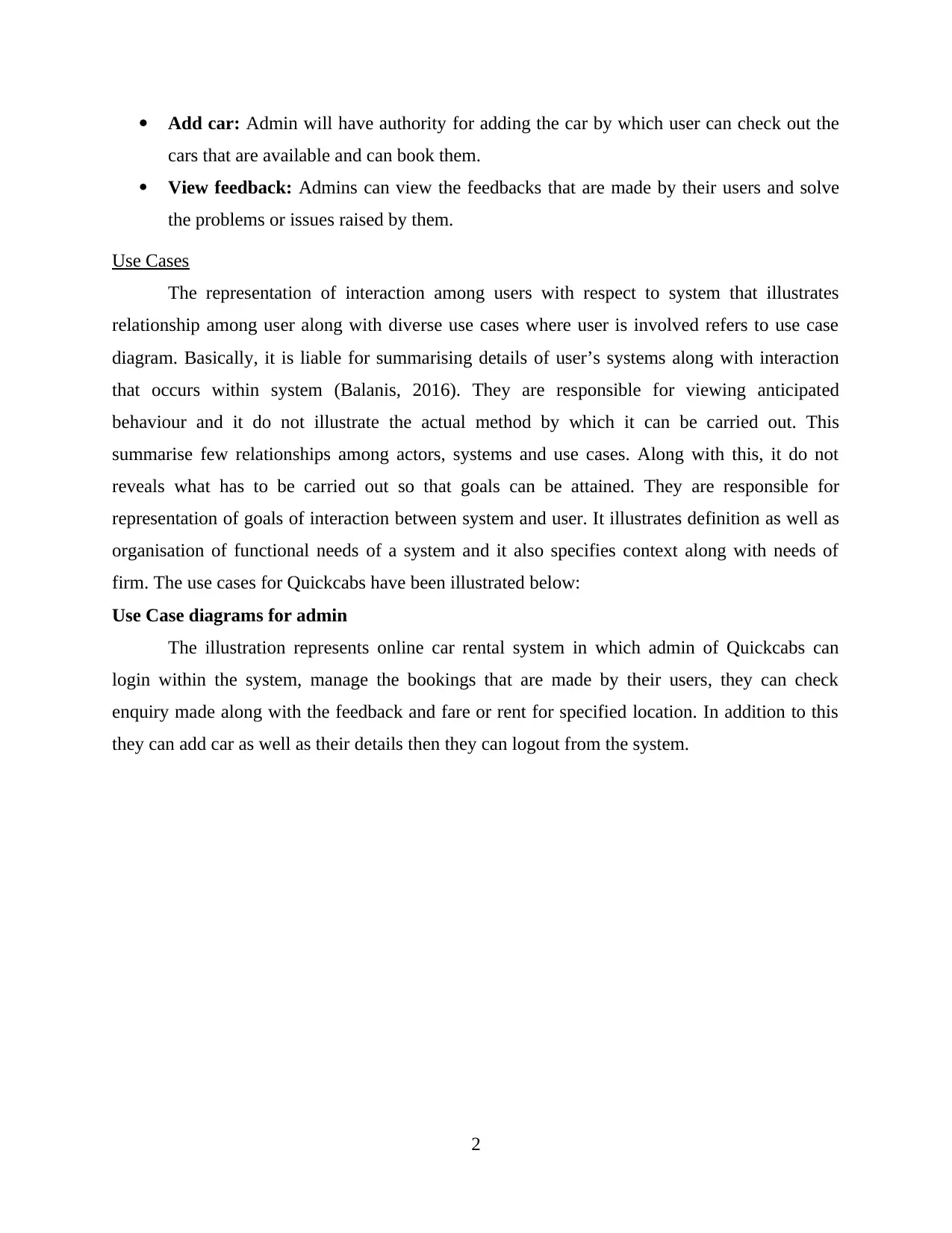
Add car: Admin will have authority for adding the car by which user can check out the
cars that are available and can book them.
View feedback: Admins can view the feedbacks that are made by their users and solve
the problems or issues raised by them.
Use Cases
The representation of interaction among users with respect to system that illustrates
relationship among user along with diverse use cases where user is involved refers to use case
diagram. Basically, it is liable for summarising details of user’s systems along with interaction
that occurs within system (Balanis, 2016). They are responsible for viewing anticipated
behaviour and it do not illustrate the actual method by which it can be carried out. This
summarise few relationships among actors, systems and use cases. Along with this, it do not
reveals what has to be carried out so that goals can be attained. They are responsible for
representation of goals of interaction between system and user. It illustrates definition as well as
organisation of functional needs of a system and it also specifies context along with needs of
firm. The use cases for Quickcabs have been illustrated below:
Use Case diagrams for admin
The illustration represents online car rental system in which admin of Quickcabs can
login within the system, manage the bookings that are made by their users, they can check
enquiry made along with the feedback and fare or rent for specified location. In addition to this
they can add car as well as their details then they can logout from the system.
2
cars that are available and can book them.
View feedback: Admins can view the feedbacks that are made by their users and solve
the problems or issues raised by them.
Use Cases
The representation of interaction among users with respect to system that illustrates
relationship among user along with diverse use cases where user is involved refers to use case
diagram. Basically, it is liable for summarising details of user’s systems along with interaction
that occurs within system (Balanis, 2016). They are responsible for viewing anticipated
behaviour and it do not illustrate the actual method by which it can be carried out. This
summarise few relationships among actors, systems and use cases. Along with this, it do not
reveals what has to be carried out so that goals can be attained. They are responsible for
representation of goals of interaction between system and user. It illustrates definition as well as
organisation of functional needs of a system and it also specifies context along with needs of
firm. The use cases for Quickcabs have been illustrated below:
Use Case diagrams for admin
The illustration represents online car rental system in which admin of Quickcabs can
login within the system, manage the bookings that are made by their users, they can check
enquiry made along with the feedback and fare or rent for specified location. In addition to this
they can add car as well as their details then they can logout from the system.
2
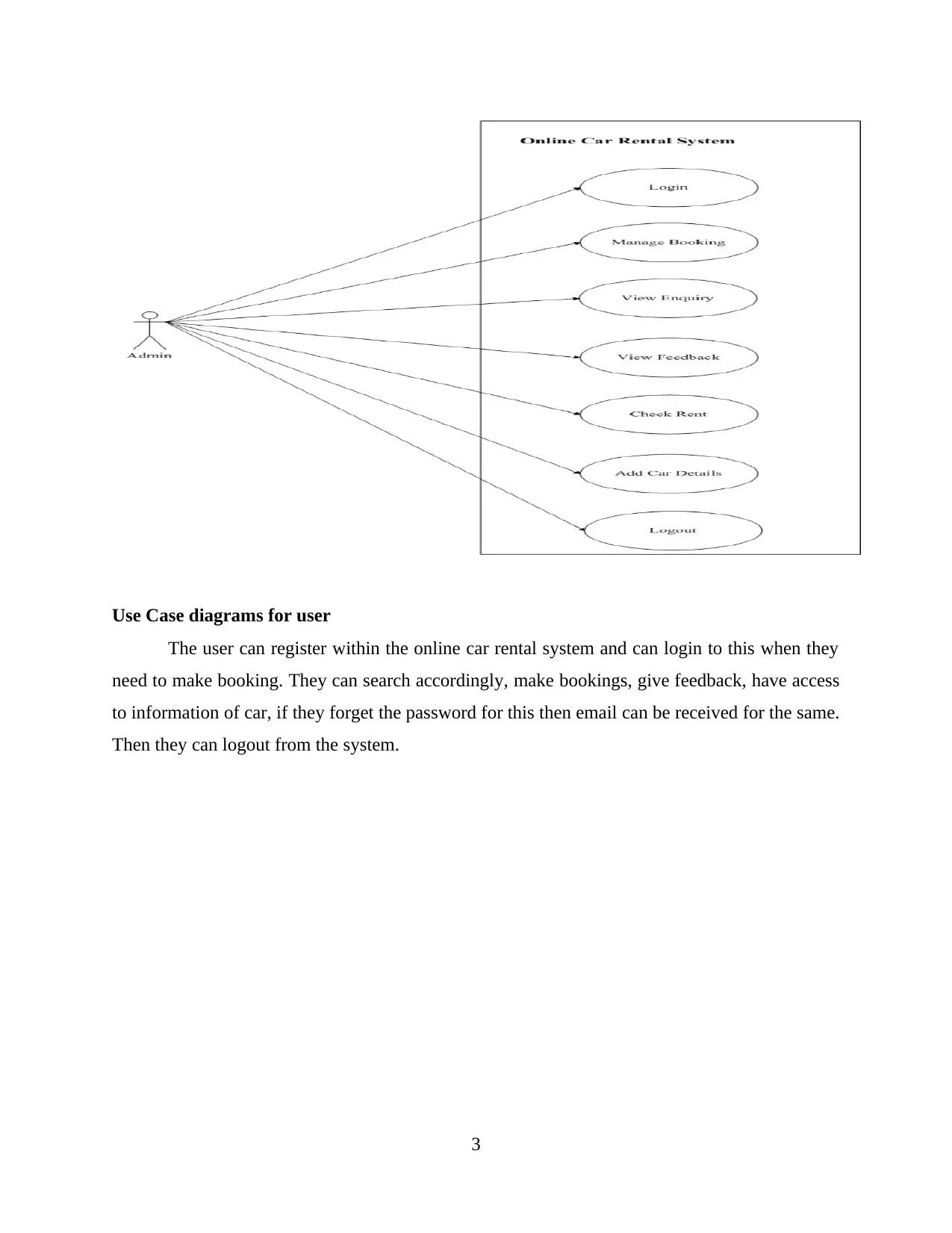
Use Case diagrams for user
The user can register within the online car rental system and can login to this when they
need to make booking. They can search accordingly, make bookings, give feedback, have access
to information of car, if they forget the password for this then email can be received for the same.
Then they can logout from the system.
3
The user can register within the online car rental system and can login to this when they
need to make booking. They can search accordingly, make bookings, give feedback, have access
to information of car, if they forget the password for this then email can be received for the same.
Then they can logout from the system.
3
⊘ This is a preview!⊘
Do you want full access?
Subscribe today to unlock all pages.

Trusted by 1+ million students worldwide
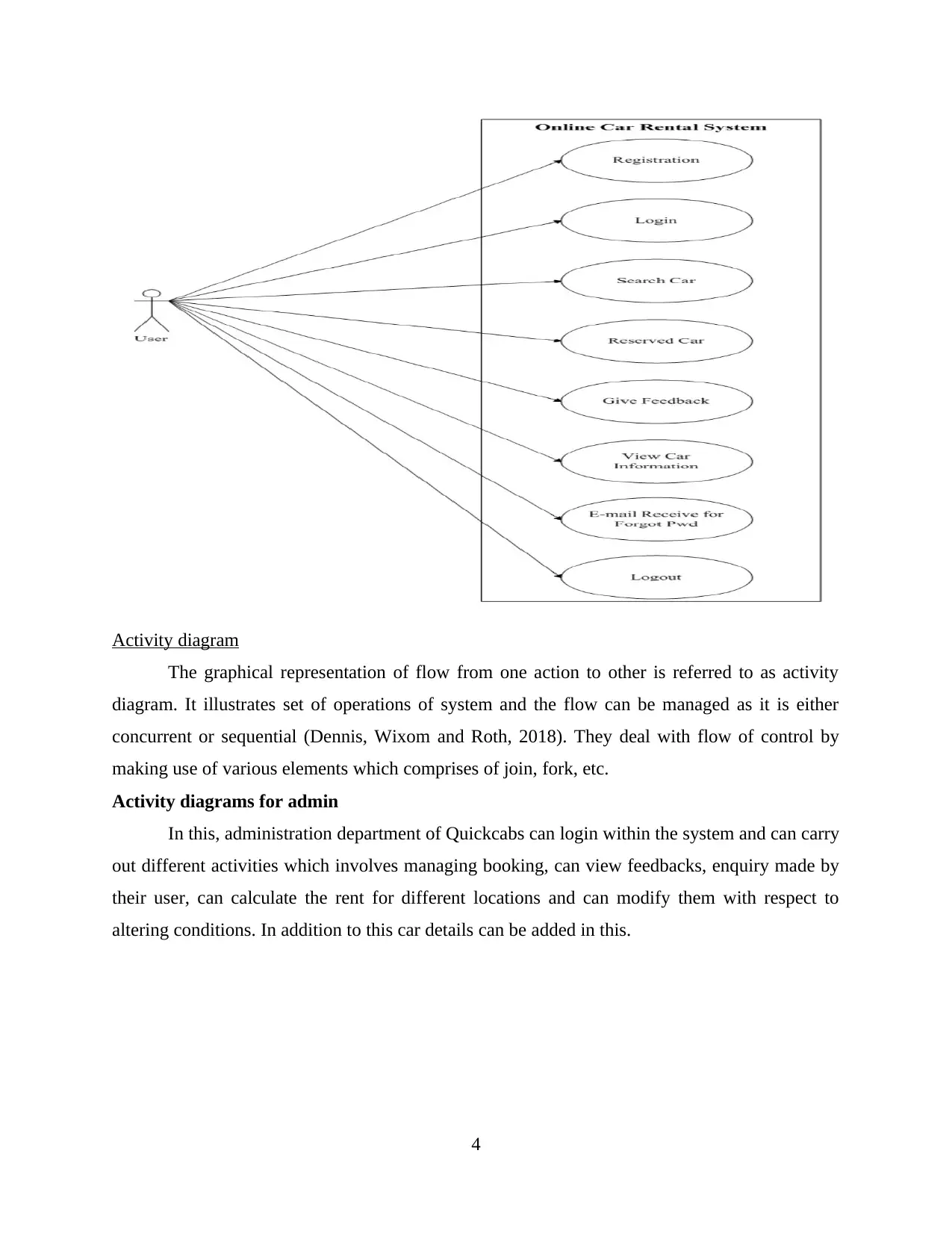
Activity diagram
The graphical representation of flow from one action to other is referred to as activity
diagram. It illustrates set of operations of system and the flow can be managed as it is either
concurrent or sequential (Dennis, Wixom and Roth, 2018). They deal with flow of control by
making use of various elements which comprises of join, fork, etc.
Activity diagrams for admin
In this, administration department of Quickcabs can login within the system and can carry
out different activities which involves managing booking, can view feedbacks, enquiry made by
their user, can calculate the rent for different locations and can modify them with respect to
altering conditions. In addition to this car details can be added in this.
4
The graphical representation of flow from one action to other is referred to as activity
diagram. It illustrates set of operations of system and the flow can be managed as it is either
concurrent or sequential (Dennis, Wixom and Roth, 2018). They deal with flow of control by
making use of various elements which comprises of join, fork, etc.
Activity diagrams for admin
In this, administration department of Quickcabs can login within the system and can carry
out different activities which involves managing booking, can view feedbacks, enquiry made by
their user, can calculate the rent for different locations and can modify them with respect to
altering conditions. In addition to this car details can be added in this.
4
Paraphrase This Document
Need a fresh take? Get an instant paraphrase of this document with our AI Paraphraser
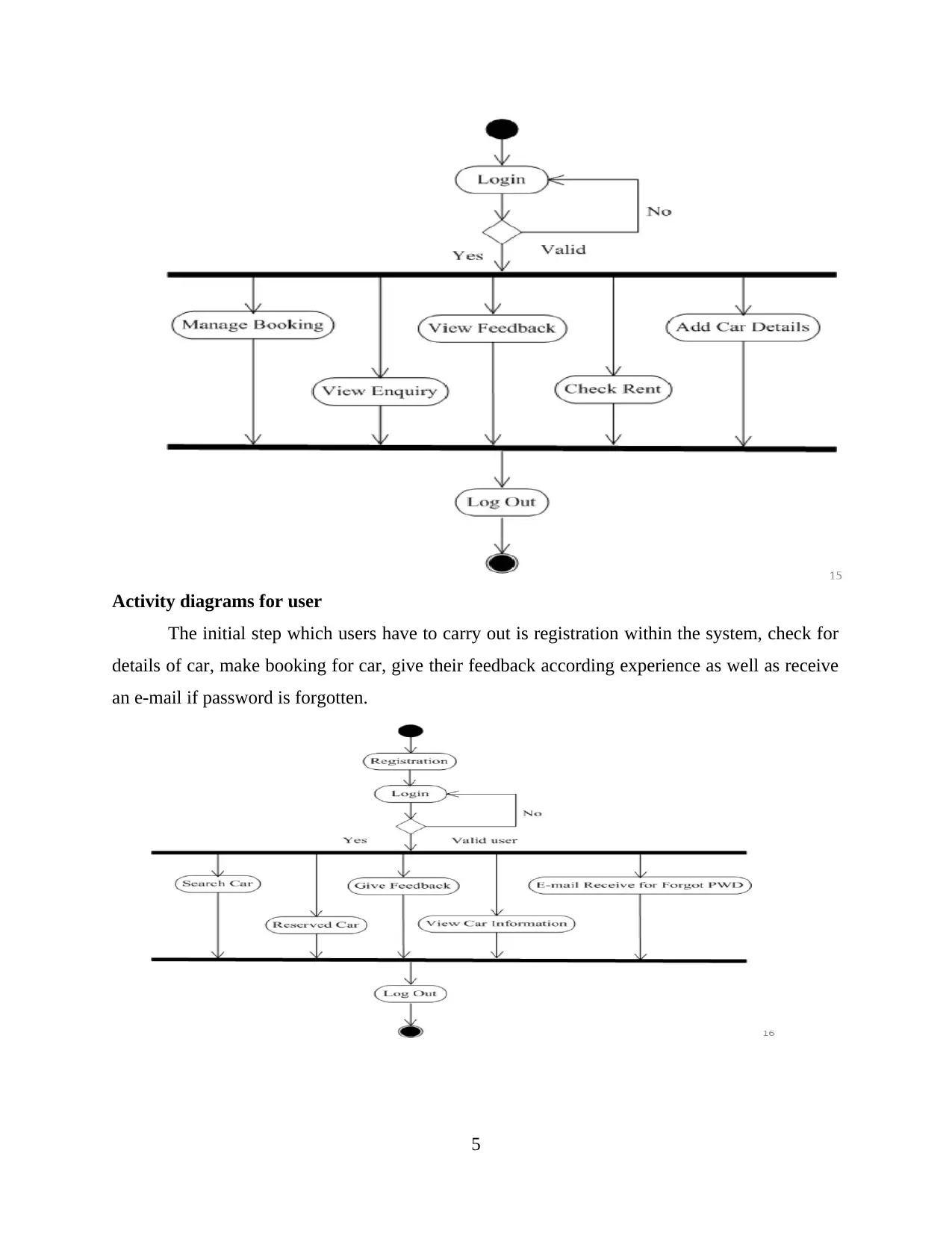
Activity diagrams for user
The initial step which users have to carry out is registration within the system, check for
details of car, make booking for car, give their feedback according experience as well as receive
an e-mail if password is forgotten.
5
The initial step which users have to carry out is registration within the system, check for
details of car, make booking for car, give their feedback according experience as well as receive
an e-mail if password is forgotten.
5
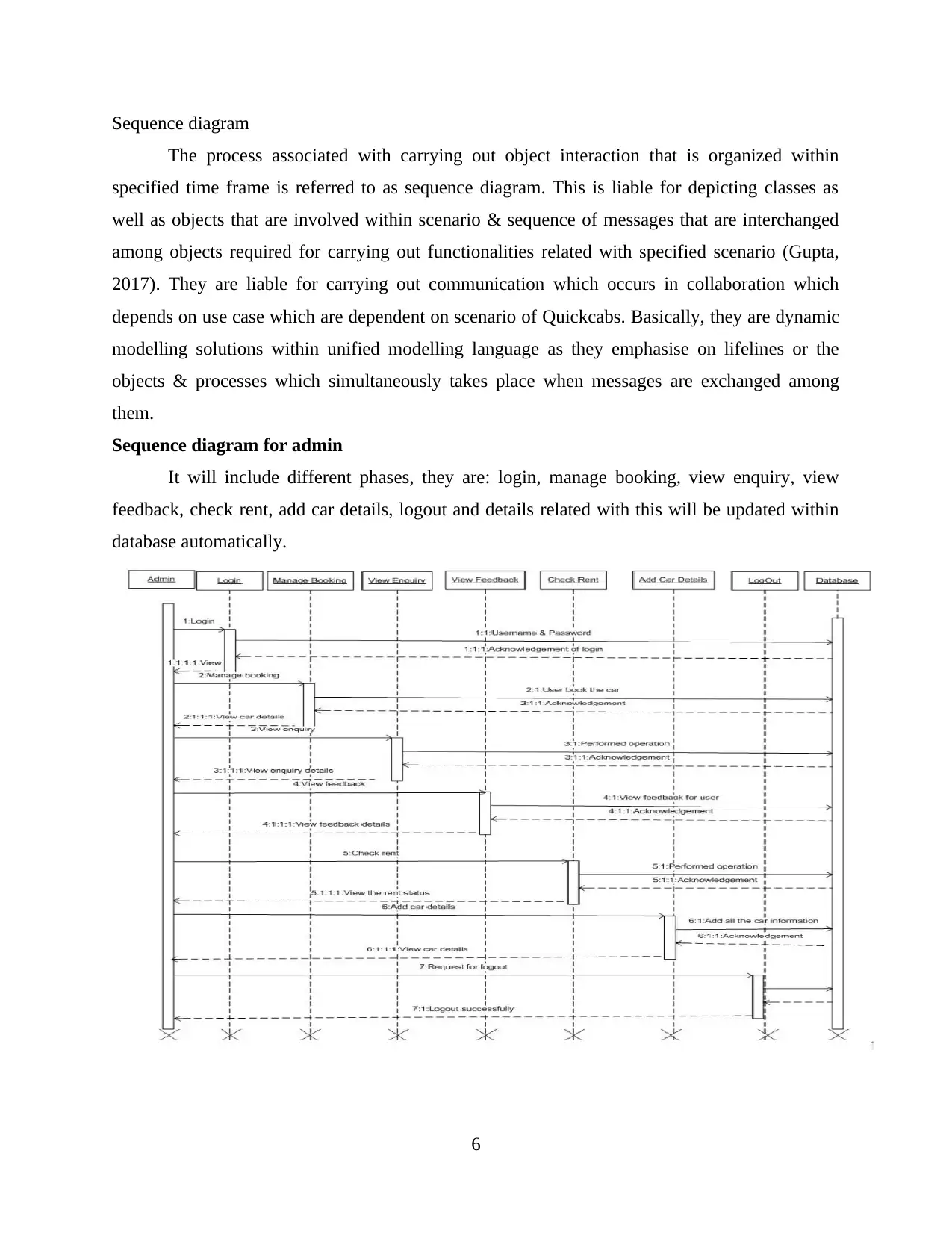
Sequence diagram
The process associated with carrying out object interaction that is organized within
specified time frame is referred to as sequence diagram. This is liable for depicting classes as
well as objects that are involved within scenario & sequence of messages that are interchanged
among objects required for carrying out functionalities related with specified scenario (Gupta,
2017). They are liable for carrying out communication which occurs in collaboration which
depends on use case which are dependent on scenario of Quickcabs. Basically, they are dynamic
modelling solutions within unified modelling language as they emphasise on lifelines or the
objects & processes which simultaneously takes place when messages are exchanged among
them.
Sequence diagram for admin
It will include different phases, they are: login, manage booking, view enquiry, view
feedback, check rent, add car details, logout and details related with this will be updated within
database automatically.
6
The process associated with carrying out object interaction that is organized within
specified time frame is referred to as sequence diagram. This is liable for depicting classes as
well as objects that are involved within scenario & sequence of messages that are interchanged
among objects required for carrying out functionalities related with specified scenario (Gupta,
2017). They are liable for carrying out communication which occurs in collaboration which
depends on use case which are dependent on scenario of Quickcabs. Basically, they are dynamic
modelling solutions within unified modelling language as they emphasise on lifelines or the
objects & processes which simultaneously takes place when messages are exchanged among
them.
Sequence diagram for admin
It will include different phases, they are: login, manage booking, view enquiry, view
feedback, check rent, add car details, logout and details related with this will be updated within
database automatically.
6
⊘ This is a preview!⊘
Do you want full access?
Subscribe today to unlock all pages.

Trusted by 1+ million students worldwide
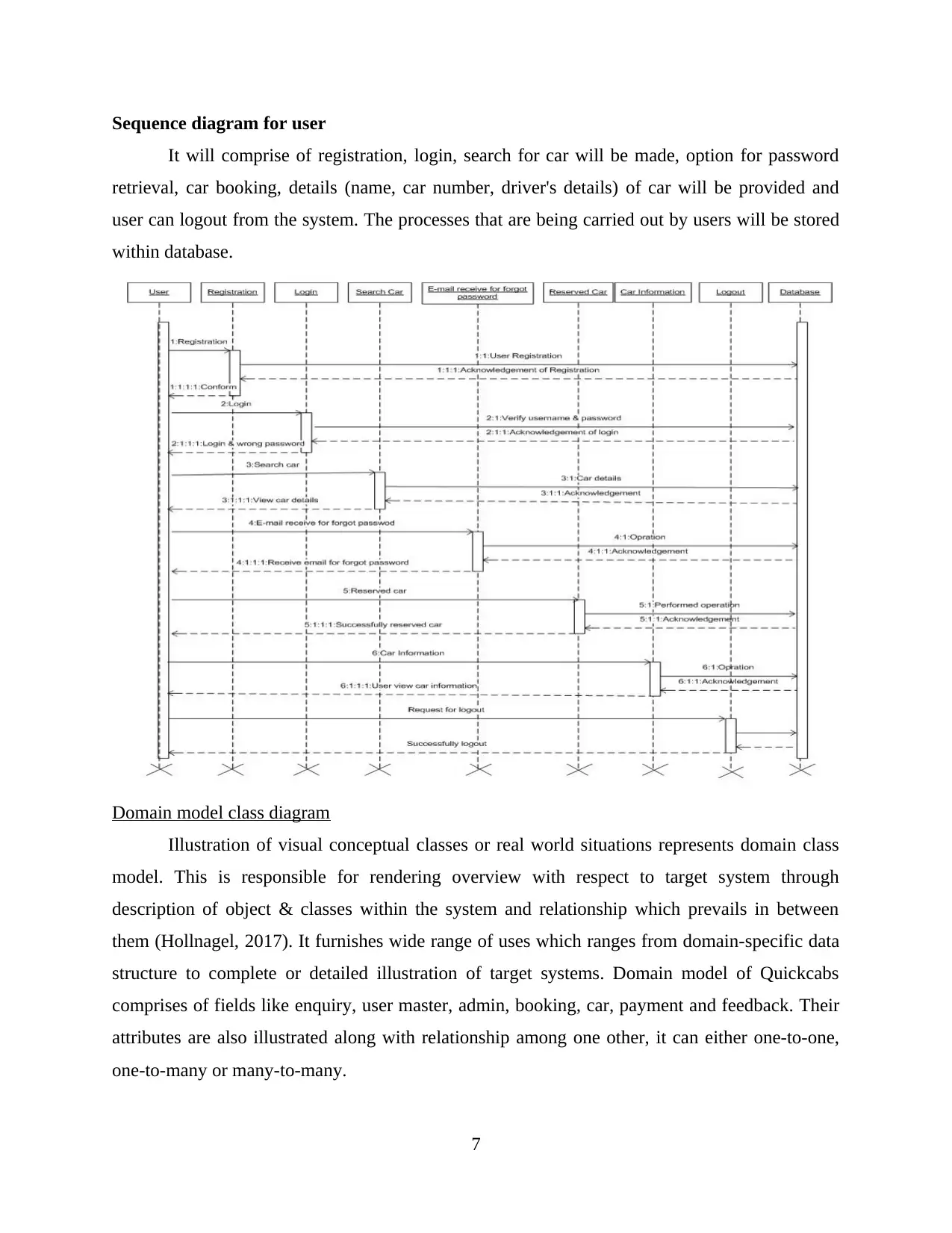
Sequence diagram for user
It will comprise of registration, login, search for car will be made, option for password
retrieval, car booking, details (name, car number, driver's details) of car will be provided and
user can logout from the system. The processes that are being carried out by users will be stored
within database.
Domain model class diagram
Illustration of visual conceptual classes or real world situations represents domain class
model. This is responsible for rendering overview with respect to target system through
description of object & classes within the system and relationship which prevails in between
them (Hollnagel, 2017). It furnishes wide range of uses which ranges from domain-specific data
structure to complete or detailed illustration of target systems. Domain model of Quickcabs
comprises of fields like enquiry, user master, admin, booking, car, payment and feedback. Their
attributes are also illustrated along with relationship among one other, it can either one-to-one,
one-to-many or many-to-many.
7
It will comprise of registration, login, search for car will be made, option for password
retrieval, car booking, details (name, car number, driver's details) of car will be provided and
user can logout from the system. The processes that are being carried out by users will be stored
within database.
Domain model class diagram
Illustration of visual conceptual classes or real world situations represents domain class
model. This is responsible for rendering overview with respect to target system through
description of object & classes within the system and relationship which prevails in between
them (Hollnagel, 2017). It furnishes wide range of uses which ranges from domain-specific data
structure to complete or detailed illustration of target systems. Domain model of Quickcabs
comprises of fields like enquiry, user master, admin, booking, car, payment and feedback. Their
attributes are also illustrated along with relationship among one other, it can either one-to-one,
one-to-many or many-to-many.
7
Paraphrase This Document
Need a fresh take? Get an instant paraphrase of this document with our AI Paraphraser
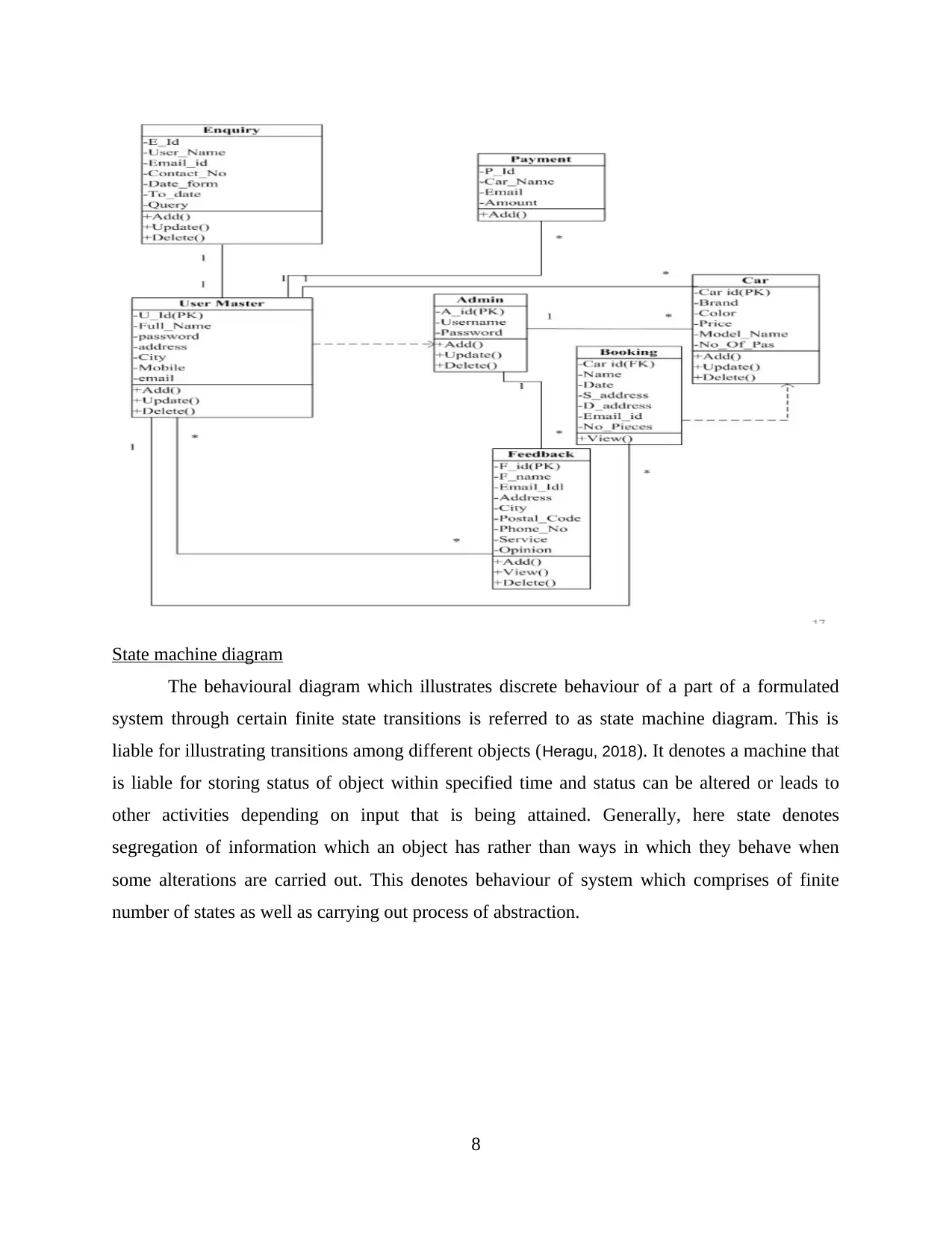
State machine diagram
The behavioural diagram which illustrates discrete behaviour of a part of a formulated
system through certain finite state transitions is referred to as state machine diagram. This is
liable for illustrating transitions among different objects (Heragu, 2018). It denotes a machine that
is liable for storing status of object within specified time and status can be altered or leads to
other activities depending on input that is being attained. Generally, here state denotes
segregation of information which an object has rather than ways in which they behave when
some alterations are carried out. This denotes behaviour of system which comprises of finite
number of states as well as carrying out process of abstraction.
8
The behavioural diagram which illustrates discrete behaviour of a part of a formulated
system through certain finite state transitions is referred to as state machine diagram. This is
liable for illustrating transitions among different objects (Heragu, 2018). It denotes a machine that
is liable for storing status of object within specified time and status can be altered or leads to
other activities depending on input that is being attained. Generally, here state denotes
segregation of information which an object has rather than ways in which they behave when
some alterations are carried out. This denotes behaviour of system which comprises of finite
number of states as well as carrying out process of abstraction.
8
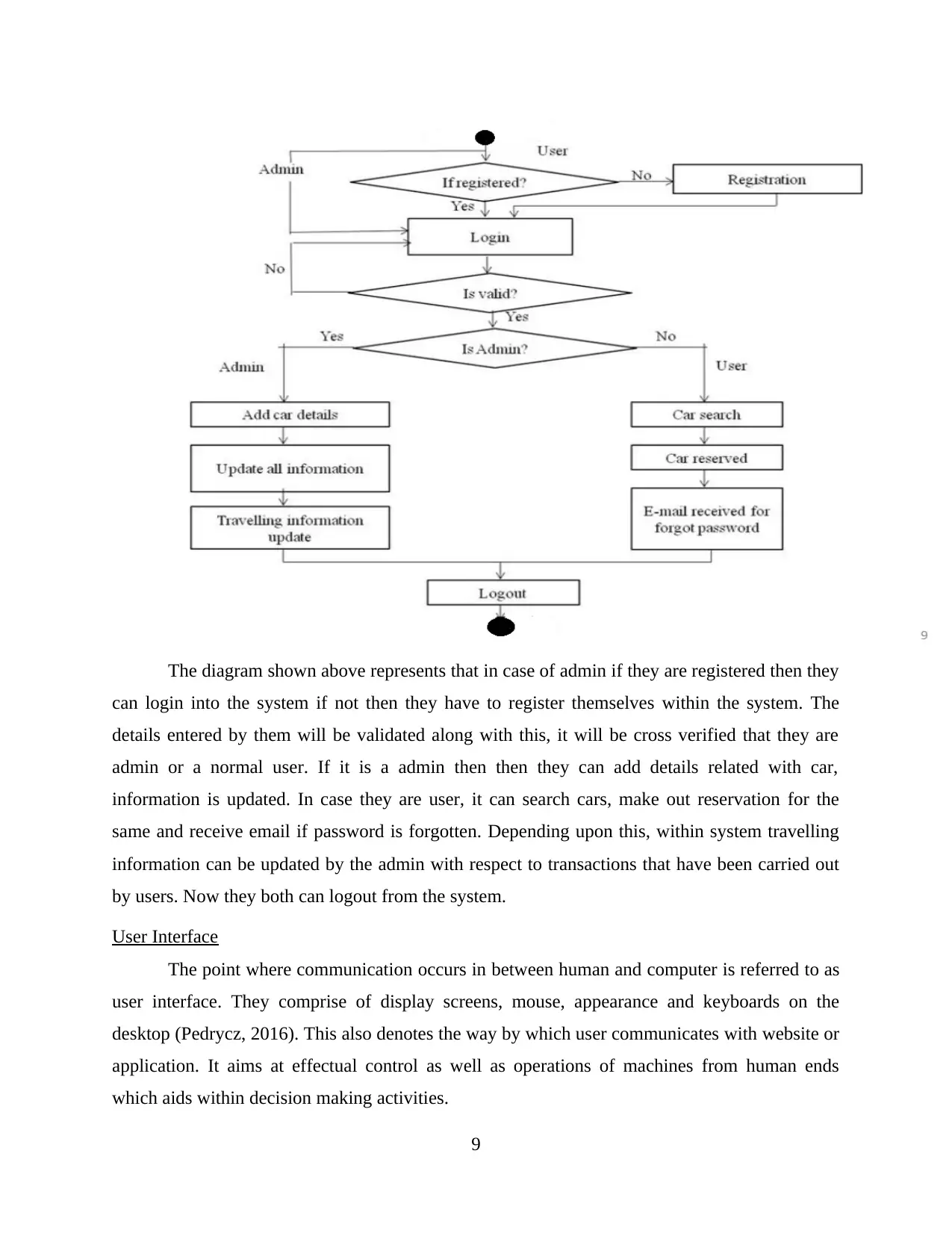
The diagram shown above represents that in case of admin if they are registered then they
can login into the system if not then they have to register themselves within the system. The
details entered by them will be validated along with this, it will be cross verified that they are
admin or a normal user. If it is a admin then then they can add details related with car,
information is updated. In case they are user, it can search cars, make out reservation for the
same and receive email if password is forgotten. Depending upon this, within system travelling
information can be updated by the admin with respect to transactions that have been carried out
by users. Now they both can logout from the system.
User Interface
The point where communication occurs in between human and computer is referred to as
user interface. They comprise of display screens, mouse, appearance and keyboards on the
desktop (Pedrycz, 2016). This also denotes the way by which user communicates with website or
application. It aims at effectual control as well as operations of machines from human ends
which aids within decision making activities.
9
can login into the system if not then they have to register themselves within the system. The
details entered by them will be validated along with this, it will be cross verified that they are
admin or a normal user. If it is a admin then then they can add details related with car,
information is updated. In case they are user, it can search cars, make out reservation for the
same and receive email if password is forgotten. Depending upon this, within system travelling
information can be updated by the admin with respect to transactions that have been carried out
by users. Now they both can logout from the system.
User Interface
The point where communication occurs in between human and computer is referred to as
user interface. They comprise of display screens, mouse, appearance and keyboards on the
desktop (Pedrycz, 2016). This also denotes the way by which user communicates with website or
application. It aims at effectual control as well as operations of machines from human ends
which aids within decision making activities.
9
⊘ This is a preview!⊘
Do you want full access?
Subscribe today to unlock all pages.

Trusted by 1+ million students worldwide
1 out of 15
Related Documents
Your All-in-One AI-Powered Toolkit for Academic Success.
+13062052269
info@desklib.com
Available 24*7 on WhatsApp / Email
![[object Object]](/_next/static/media/star-bottom.7253800d.svg)
Unlock your academic potential
Copyright © 2020–2025 A2Z Services. All Rights Reserved. Developed and managed by ZUCOL.





